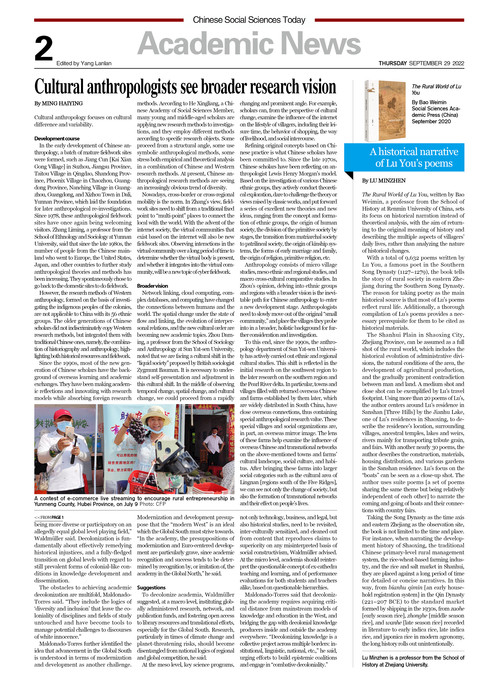A historical narrative of Lu You’s poems
2022-09-29 14:13:24
The Rural World of Lu You
By LU MINZHEN
The Rural World of Lu You, written by Bao Weimin, a professor from the School of History at Renmin University of China, sets its focus on historical narration instead of theoretical analysis, with the aim of returning to the original meaning of history and describing the multiple aspects of villagers’ daily lives, rather than analyzing the nature of historical changes.
With a total of 9,632 poems written by Lu You, a famous poet in the Southern Song Dynasty (1127–1279), the book tells the story of rural society in eastern Zhejiang during the Southern Song Dynasty. The reason for taking poetry as the main historical source is that most of Lu’s poems reflect rural life. Additionally, a thorough compilation of Lu’s poems provides a necessary prerequisite for them to be cited as historical materials.
The Shanhui Plain in Shaoxing City, Zhejiang Province, can be assumed as a full shot of the rural world, which includes the historical evolution of administrative divisions, the natural conditions of the area, the development of agricultural production, and the gradually prominent contradiction between man and land. A medium shot and close shot can be exemplified by Lu’s travel footprint. Using more than 20 poems of Lu’s, the author centers around Lu’s residence in Sanshan [Three Hills] by the Jianhu Lake, one of Lu’s residences in Shaoxing, to describe the residence’s location, surrounding villages, ancestral temples, lakes and weirs, rivers mainly for transporting tribute grain, and fairs. With another nearly 30 poems, the author describes the construction, materials, housing distribution, and various gardens in the Sanshan residence. Lu’s focus on the “boats” can be seen as a close-up shot. The author uses suite poems [a set of poems sharing the same theme but being relatively independent of each other] to narrate the coming and going of boats and their connections with country fairs.
Taking the Song Dynasty as the time axis and eastern Zhejiang as the observation site, the book is not limited to the time and place. For instance, when narrating the development history of Shaoxing, the traditional Chinese primary-level rural management system, the rice-wheat-based farming industry, and the rice and salt market in Shanhui, they are placed against a long period of time for detailed or concise narratives. In this way, from bianhu qimin [an early household registration system] in the Qin Dynasty (221–207 BCE) to the standard market formed by shipping in the 1930s, from zaohe [early season rice], zhonghe [middle season rice], and wanhe [late season rice] recorded in literature to early indica rice, late indica rice, and japonica rice in modern agronomy, the long history rolls out unintentionally.
Lu Minzhen is a professor from the School of History at Zhejiang University.



